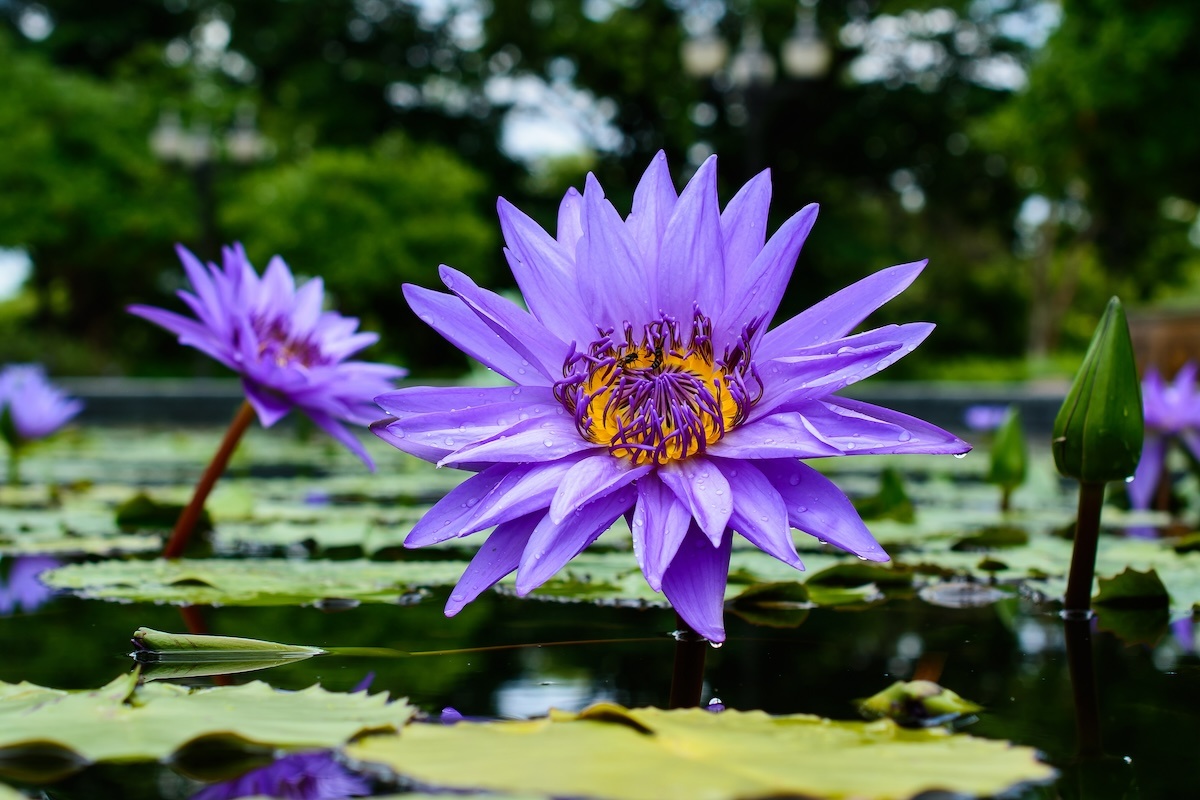Blue Lotus: The Ancient Flower of Relaxation & Euphoria
The Blue Lotus, also known as Nymphaea caerulea, is a special water lily that has been used for thousands of years for its spiritual, healing, and relaxing properties. The flower played an important role in ancient Egypt and is still appreciated today for its calming and mildly euphoric effects. In this article, we discuss the history, effects, applications, and scientific findings about the Blue Lotus.
Types of Blue Lotus Products
Experience the fascinating world of Blue Lotus! Discover our high-quality Blue Lotus products.
Go to Blue Lotus PageWhat is Blue Lotus?
The Blue Lotus (Nymphaea caerulea) is a tropical water lily mainly found in Egypt and other parts of Africa, but it also grows in some regions of Asia. The flower has striking blue-violet petals and a sweet fragrance and was often depicted in ancient art and hieroglyphs.
Traditionally, this plant has been used for its mildly psychoactive and relaxing properties. The flowers contain natural alkaloids such as nuciferine and aporphine, which have calming effects and may influence mood, sleep, and mental clarity.
Blue Lotus grows in still or slow-moving waters, anchoring itself with rhizomes in muddy soil. The flowers open during the day and close at night, which in ancient Egypt symbolized rebirth and the cycle of the sun.
Blue Lotus is often confused with the Sacred Lotus (Nelumbo nucifera), but they are different plants. While the Sacred Lotus is more associated with meditation and spiritual purification, the Blue Lotus is known for its relaxing and mildly euphoric effects.

Historical & Spiritual Significance
The Blue Lotus was highly significant in ancient Egypt and is often depicted in temple inscriptions, artworks, and hieroglyphs. The flower was associated with spirituality, enlightenment, and divine energy. It was attributed to various gods, including:
Osiris (God of the Afterlife) – Symbolized transformation and spiritual awakening.
Ra (Sun God) – Represented life, rebirth, and the cycle of the sun.
Nefertem (God of Beauty and Healing) – Often depicted with a Blue Lotus on his head.
In ancient Egyptian ceremonies, Blue Lotus was infused in wine to enhance its effects. It was believed that its use promoted deep relaxation, spiritual insights, and heightened awareness.
Effects of Blue Lotus on the Body
The effects of Blue Lotus are due to a combination of alkaloids, flavonoids, and other bioactive substances that interact with dopamine, serotonin, and GABA receptors. This leads to a relaxing, mildly euphoric, and potentially psychoactive effect, depending on the dosage and method of consumption. While more scientific studies are needed to fully understand its effects, both traditional uses and modern research suggest that Blue Lotus is a versatile plant with potentially interesting benefits for relaxation and well-being.
Benefits & Effects of Blue Lotus
The Blue Lotus is known for a variety of therapeutic and relaxing benefits, including:
1. Relaxation & Stress Reduction
Acts as a natural sedative that helps reduce anxiety and stress.
Ideal for use after a long day or to support meditation.
2. Mild Euphoria & Mood Enhancement
Many users experience a subtle but pleasant mood boost.
Provides a mild, relaxing sensation without overwhelming psychoactive effects.
3. Improved Sleep
Helps with insomnia and restless nights.
Can improve sleep quality and depth.
4. Muscle Relaxation & Pain Relief
May help with muscle tension, pain, and menstrual discomfort.
Sometimes used as a mild pain reliever.
5. Enhanced Focus & Spiritual Deepening
Promotes mental clarity and focus – ideal for meditation and creative activities.
Frequently used in yoga, breathwork, and spiritual rituals.
How to Use Blue Lotus?
Blue Lotus can be used in various ways, depending on the desired effects. Below, we explain the methods of use, effects, and dosages.
1. Blue Lotus Tea
How to Prepare It?
Take 5-10 grams of dried Blue Lotus flowers.
Bring 250-500 ml of water to a boil and let it cool to about 80-90°C.
Add the flowers and let them steep for 10-15 minutes.
Strain the tea and drink slowly.
Effects & Benefits:
Relaxing and stress-reducing
Great for meditation and sleep
Mild euphoric effects at higher doses
Dosage:
Mild relaxation: 5 grams of dried flowers
Stronger effect: 10 grams of dried flowers
Tip: Add honey or lemon for a better taste.
2. Blue Lotus in Wine (Egyptian Method)
How to Prepare It?
Take 5 grams of dried flowers per 250 ml of wine.
Let the flowers steep for at least 2 hours (for a stronger effect, leave overnight).
Strain the flowers before drinking.
Effects & Benefits:
Mild euphoric and relaxing effects
Can create a warm, dreamy sensation
The combination of alcohol and Blue Lotus enhances relaxation
Dosage:
Mild relaxation: 5 grams of flowers per glass of wine
Stronger effect: 10 grams of flowers per glass of wine
Note: Excessive consumption may cause drowsiness. Use in moderation and do not mix with other sedatives.
3. Blue Lotus Extracts & Tinctures
How to Use an Extract?
Extracts and tinctures are concentrated forms of Blue Lotus, often 15x or 25x stronger than dried flowers.
Tincture: Add 3-10 drops to water, tea, or juice.
Powdered Extract: Mix 100-200 mg with a beverage or take it directly under the tongue.
Effects & Benefits:
Stronger effects with lower dosage
Convenient for travel or quick relaxation
Fast absorption in the body
Dosage:
Mild effect: 3-5 drops of tincture or 100 mg of extract
Strong effect: 8-10 drops of tincture or 200 mg of extract
Note: Extracts and tinctures are stronger than regular flowers, so it's best to start with a low dose.
4. Smoking Blue Lotus
How to Smoke Blue Lotus?
Use dried Blue Lotus flowers.
Crush the flowers slightly for even burning.
Smoke them pure or mix them with other herbs like Damiana or Wild Dagga.
Light and inhale slowly.
Effects & Benefits:
Quick relaxation and mild euphoria
Can provide a calming and dreamlike sensation
Suitable for meditation and stress relief
Dosage:
0.5 - 0.8g dried flowers
Tip: Combine it with other herbs for a milder taste and a unique experience.
5. Vaping Blue Lotus (Vaporizer)
How to Vape Blue Lotus?
Use a vaporizer that is suitable for herbs.
Set the temperature to 110°C to optimally extract the active compounds.
Crush the flowers and place them in the herb chamber.
Inhale slowly and deeply for the best effect.
Effects & Benefits:
Faster absorption compared to tea or tinctures
Gentle, mild euphoria and deep relaxation
Cleaner method without combustion
Ideal for meditation and stress relief
Dosage:
Mild effect: 200-400 mg dried flowers
Stronger effect: 800 mg to 1 gram
Note: Start with a low dose and gradually increase as needed.

Precautions & Possible Side Effects
Although Blue Lotus is generally safe when used in moderation, there are some points to consider:
Possible Side Effects:
Mild dizziness or drowsiness at high doses.
Nausea or stomach discomfort with excessive consumption.
May lower blood pressure, so caution is advised for people with low blood pressure.
Who Should Be Cautious?
Pregnant or breastfeeding women.
People taking sedatives or antidepressants (possible interactions).
Individuals with low blood pressure (due to its relaxing effect).
Always start with a low dosage and consult a doctor if you have concerns.
Legal Status and Special Considerations of Blue Lotus
Blue Lotus (Nymphaea caerulea) is a fascinating plant with a long history in various cultures. Due to its versatile applications, questions often arise regarding its legal status.
Is Blue Lotus Legal?
In most countries, Blue Lotus is not classified as a controlled substance and is therefore legally available. It is commonly sold as tea, extract, or incense. However, there are some regional differences, so it is advisable to check the current regulations in your country or state before purchasing.
Conclusion: Is Blue Lotus Right for You?
Blue Lotus is a fascinating plant with a rich history and versatile applications. Whether you are looking for relaxation, mild euphoria, or spiritual deepening, this flower offers a natural and gentle way to enhance your well-being.
If you want to try it, start with tea or a low-dose tincture to see how it affects you. As with all herbs, moderation is the key to a safe and enjoyable experience.
Would you try Blue Lotus? Let us know!












